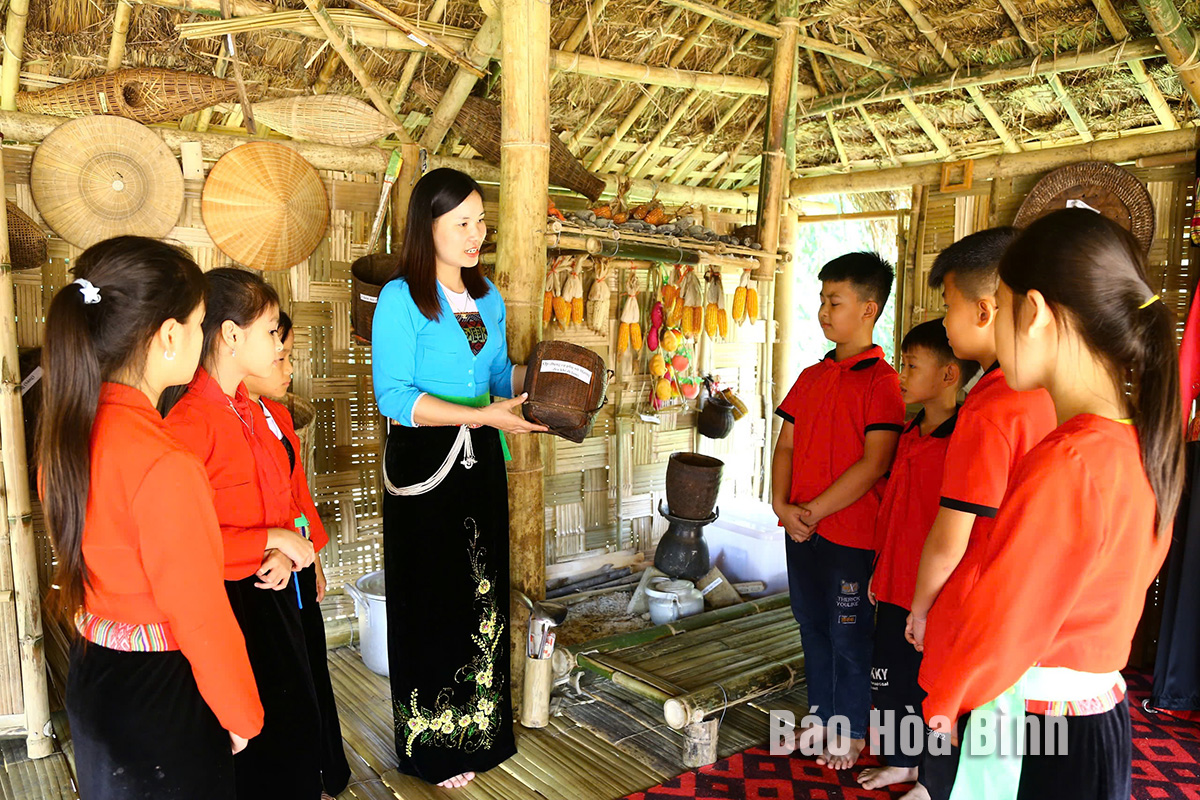Preserving and promoting the cultural values of the Muong ethnic group has become an urgent task in the current context, as many traditional values face the risk of fading away. This effort requires not only protecting the cultural identity but also eliminating outdated customs and developing a modern cultural lifestyle, contributing to sustainable values for the Muong community in Hoa Binh province.
The Muong culture is included the curriculum of the
Do Nhan primary and secondary school (Tan Lac district).
Identifying challenges
Quach Thi Kieu, Director of the provincial
Department of Culture, Sports and Tourism, acknowledged recent progress in
preserving the cultural values of the Muong ethnic group. However, she warned
that the pressure of a market economy have caused some communities to drift
toward materialism, gradually eroding traditional cultural values. Several
heritage elements of the Muong culture are now at risk of disappearing.
Despite the richness of the Muong heritage,
investment in its preservation and promotion remains insufficient. Many
significant cultural assets have yet to be studied, documented, or restored.
Efforts to survey intangible cultural heritage are still limited, and the
preparation of dossiers to nominate the Muong culture for inclusion in the list
of national intangible cultural heritage is still limited.
Efforts to promote and raise awareness of the
Muong cultural heritage in Hoa Binh remain ineffective. Exhibitions at the
provincial museum lack appeal while facilities for showcasing the Muong
heritage are underdeveloped. Social mobilisation and private-sector involvement
in heritage conservation is still modest.
Additionally, heritage sites continue to face
threats from vandalism and theft. Several sites are deteriorating without
proper restoration, and there are a shortage of support policies for Muong
artisans—especially those honoured with the titles "People’s Artisan” or
"Meritorious Artisan”—who are actively passing down traditional knowledge to
younger generations.
Sharing concerns about these challenges, artisan
Bui Van Rum in Rom Co hamlet, Thuong Coc commune (Lac Son district), noted that
many cultural treasures such as the Mo Muong ritual, are at risk of being lost.
"We remain passionate and committed to
preservation, but our biggest worry is the lack of young successors who are
willing to learn and carry on this legacy,” he said.
Efforts to keep Muong culture heritage
everlasting
Amid challenges to preservation efforts, local
authorities have taken proactive steps to safeguard and promote the cultural
heritage of the Muong ethnic group. For the first time, the preservation and
promotion of the Muong culture and the Hoa Binh Civilisation have been
identified as a strategic breakthrough of the province.
The provincial Party Committee's Standing Board
has focused on concrete directives and solutions to ensure that the Muong
culture is not only preserved but also integrated into community life in
meaningful ways.
In 2023, Hoa Binh launched a plan on
preservingandpromotingthe values of the Muong ethnic culture
and the Hoa Binh Civilisation for the 2023–2030 period. The initiative
allocates over 500 billion VND (21 million USD) to support the efforts. A key
component of the plan is building a Muongethniccultural
conservation space linked to tourism development in Tan Lac district.
The plan outlines other key actions, including
researching and collecting Muong cultural heritage elements with historical,
scientific, artistic, and aesthetic values for exhibition and promotion
activities; and developing contemporary cultural products reflecting the Muong
identity to improve tourism experiences for visitors.
It emphasises the urgent need to protect
endangered cultural knowledge as many practitioners are elderly; restore and
revive traditional festivals, traditional attire, stilt houses, folk songs, the
gong art, Mo Muong ritual, and other cultural practices. Additionally, the
province also plans to invest in the restoration and preservation of some
architectural sites that embody the unique cultural identity of the Muong
people but have deteriorated over time.
Attention will be also paid to including the
Muong culture in the school curriculum, organising extracurricular activities
that help students better understand and treasure their ethnic heritage,
issuing policies to support the artisans practicing Mo Muong and the Muong gong
art, and developing Muong culture-themed tourism linked with ecological and
relaxation tourism.



